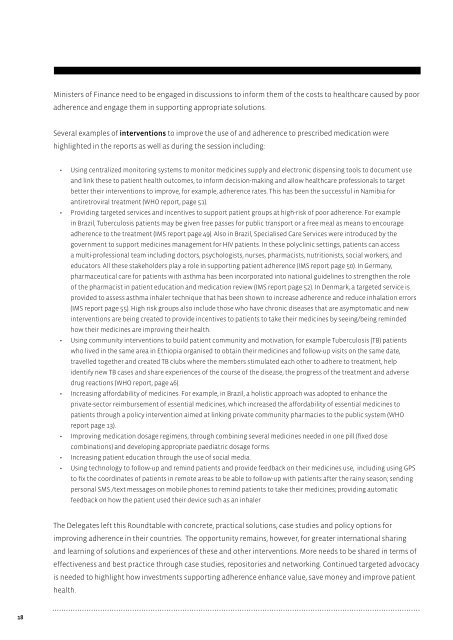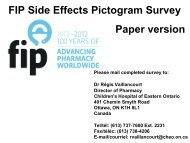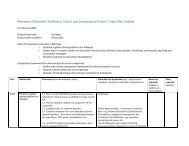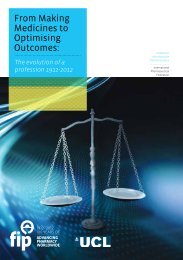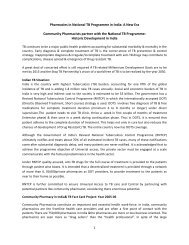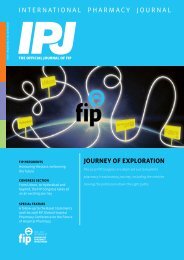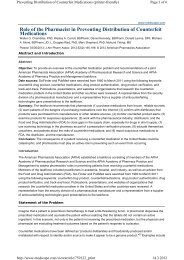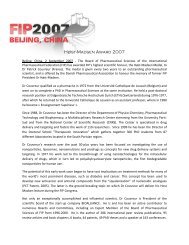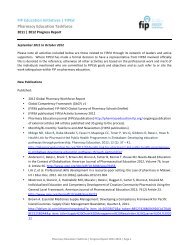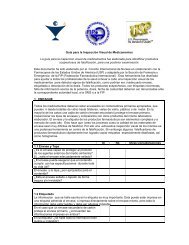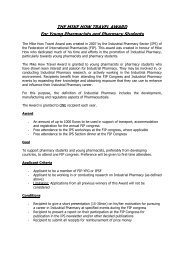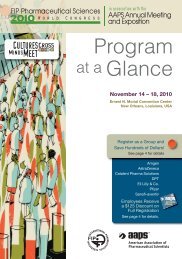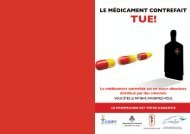here - FIP
here - FIP
here - FIP
You also want an ePaper? Increase the reach of your titles
YUMPU automatically turns print PDFs into web optimized ePapers that Google loves.
18<br />
Ministers of Finance need to be engaged in discussions to inform them of the costs to healthcare caused by poor<br />
ad<strong>here</strong>nce and engage them in supporting appropriate solutions.<br />
Several examples of interventions to improve the use of and ad<strong>here</strong>nce to prescribed medication were<br />
highlighted in the reports as well as during the session including:<br />
• Using centralized monitoring systems to monitor medicines supply and electronic dispensing tools to document use<br />
and link these to patient health outcomes, to inform decision-making and allow healthcare professionals to target<br />
better their interventions to improve, for example, ad<strong>here</strong>nce rates. This has been the successful in Namibia for<br />
antiretroviral treatment (WHO report, page 51).<br />
• Providing targeted services and incentives to support patient groups at high-risk of poor ad<strong>here</strong>nce. For example<br />
in Brazil, Tuberculosis patients may be given free passes for public transport or a free meal as means to encourage<br />
ad<strong>here</strong>nce to the treatment (IMS report page 49). Also in Brazil, Specialised Care Services were introduced by the<br />
government to support medicines management for HIV patients. In these polyclinic settings, patients can access<br />
a multi-professional team including doctors, psychologists, nurses, pharmacists, nutritionists, social workers, and<br />
educators. All these stakeholders play a role in supporting patient ad<strong>here</strong>nce (IMS report page 50). In Germany,<br />
pharmaceutical care for patients with asthma has been incorporated into national guidelines to strengthen the role<br />
of the pharmacist in patient education and medication review (IMS report page 52). In Denmark, a targeted service is<br />
provided to assess asthma inhaler technique that has been shown to increase ad<strong>here</strong>nce and reduce inhalation errors<br />
(IMS report page 55). High risk groups also include those who have chronic diseases that are asymptomatic and new<br />
interventions are being created to provide incentives to patients to take their medicines by seeing/being reminded<br />
how their medicines are improving their health.<br />
• Using community interventions to build patient community and motivation, for example Tuberculosis (TB) patients<br />
who lived in the same area in Ethiopia organised to obtain their medicines and follow-up visits on the same date,<br />
travelled together and created TB clubs w<strong>here</strong> the members stimulated each other to ad<strong>here</strong> to treatment, help<br />
identify new TB cases and share experiences of the course of the disease, the progress of the treatment and adverse<br />
drug reactions (WHO report, page 46).<br />
• Increasing affordability of medicines. For example, in Brazil, a holistic approach was adopted to enhance the<br />
private-sector reimbursement of essential medicines, which increased the affordability of essential medicines to<br />
patients through a policy intervention aimed at linking private community pharmacies to the public system (WHO<br />
report page 13).<br />
• Improving medication dosage regimens, through combining several medicines needed in one pill (fixed dose<br />
combinations) and developing appropriate paediatric dosage forms.<br />
• Increasing patient education through the use of social media.<br />
• Using technology to follow-up and remind patients and provide feedback on their medicines use, including using GPS<br />
to fix the coordinates of patients in remote areas to be able to follow-up with patients after the rainy season; sending<br />
personal SMS /text messages on mobile phones to remind patients to take their medicines; providing automatic<br />
feedback on how the patient used their device such as an inhaler<br />
The Delegates left this Roundtable with concrete, practical solutions, case studies and policy options for<br />
improving ad<strong>here</strong>nce in their countries. The opportunity remains, however, for greater international sharing<br />
and learning of solutions and experiences of these and other interventions. More needs to be shared in terms of<br />
effectiveness and best practice through case studies, repositories and networking. Continued targeted advocacy<br />
is needed to highlight how investments supporting ad<strong>here</strong>nce enhance value, save money and improve patient<br />
health.


